Abstract
In six separate experiments, 7-2% of purified peripheral blood lymphocytes from normal donors were shown to form rosettes with mouse erythrocytes. Normal T and B lymphocytes were separated according to their membrane properties, by E-rosette formation or fractionation on anti F (ab')2 column. The results obtained in both the separation procedures used were in good agreement: T lymphocytes were never found to form mouse red cell rosettes. On the contrary, enrichment of suspensions in B lymphocytes resulted in an increased percentage of mouse red-cell rosette-forming cells. Under the technical condition used, peroxidase-positive monocytes were not shown to form such rosettes. However, if all the mouse red cell rosette-forming cells were shown to be of B nature, not all the B lymphocytes form rosettes with mouse erythrocytes and it is not unlikely that this marker could be characteristic for a subset of Ig-bearing B lymphocytes.
Full text
PDF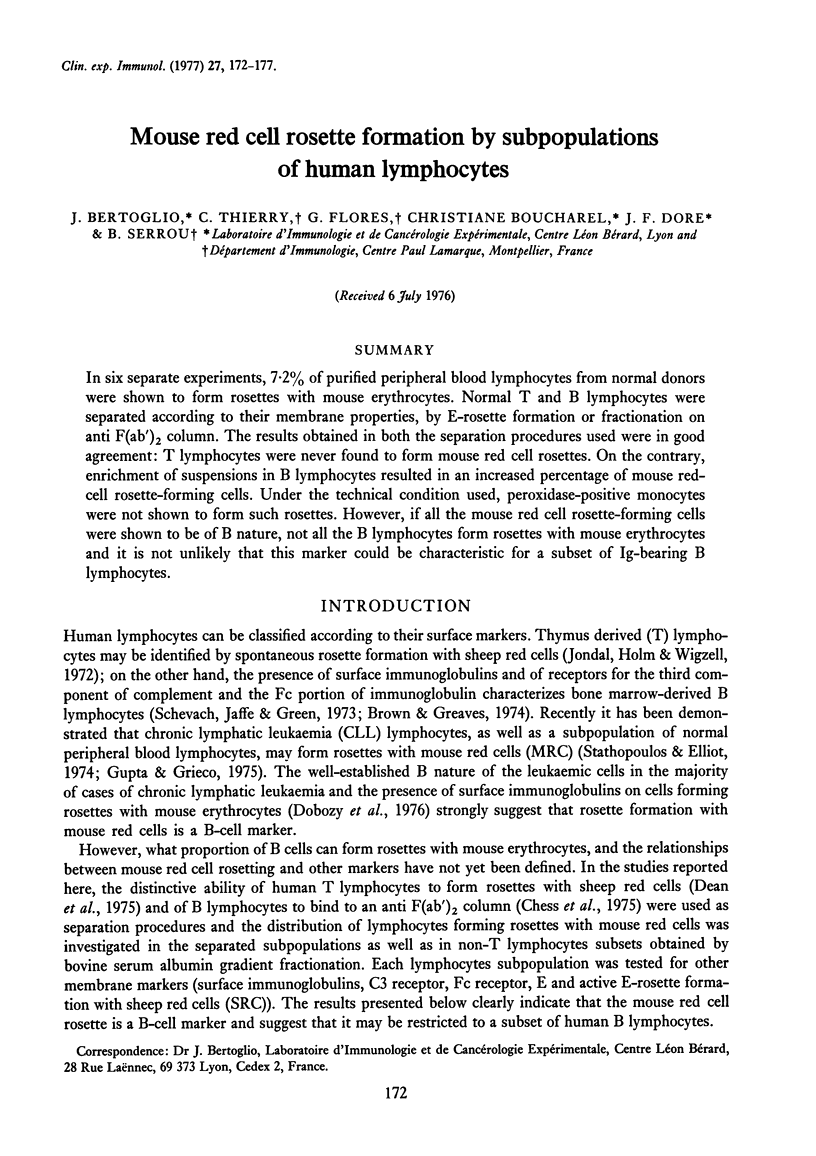
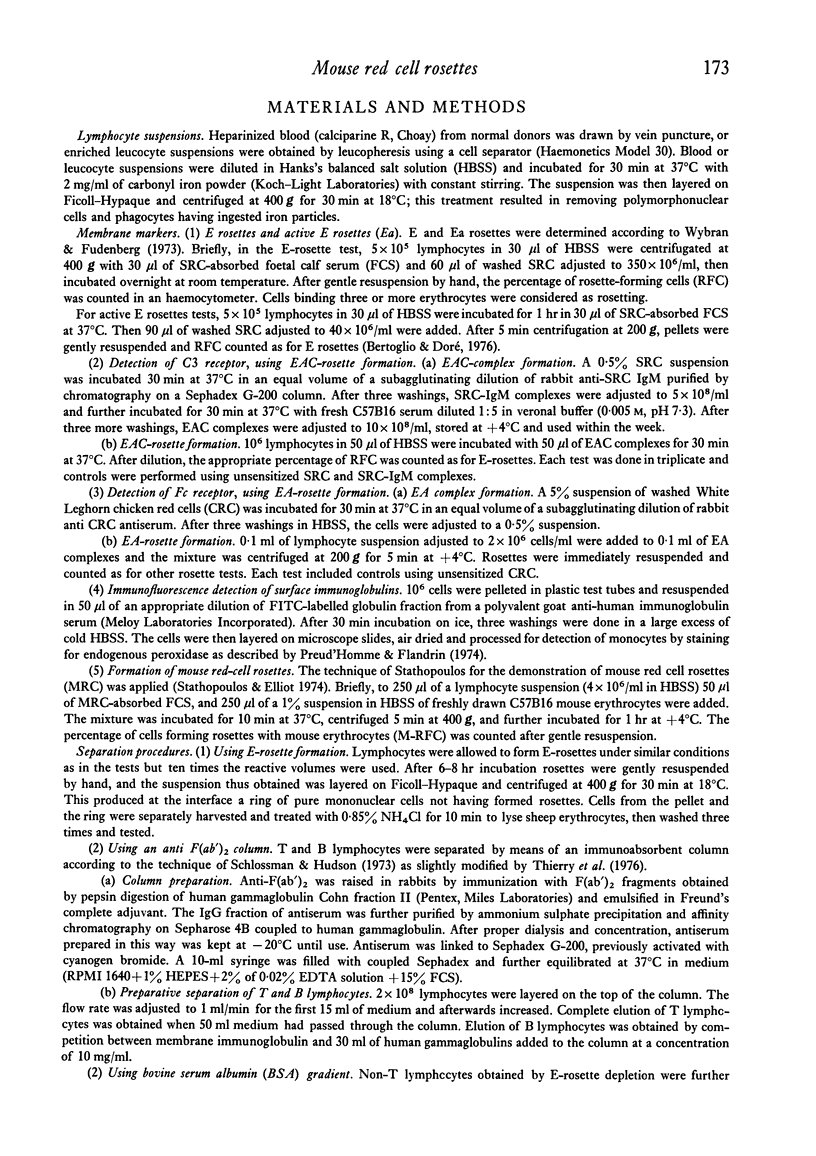
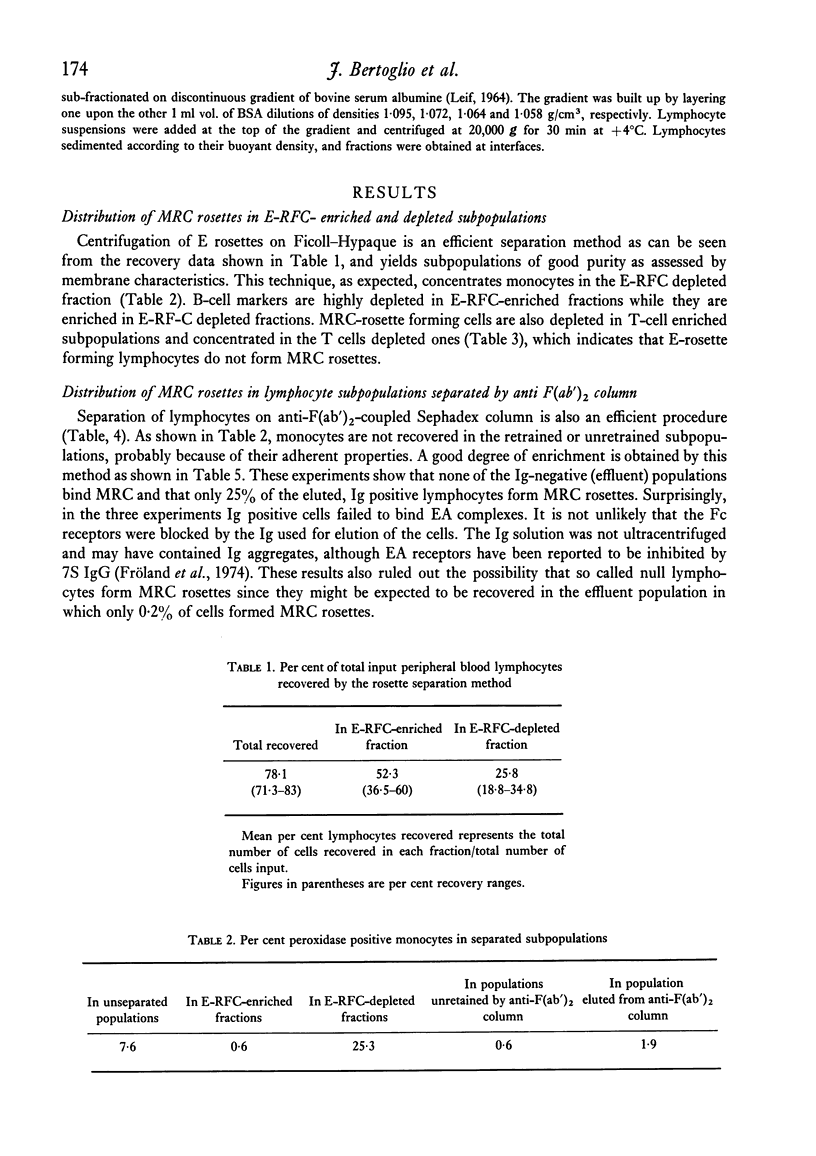
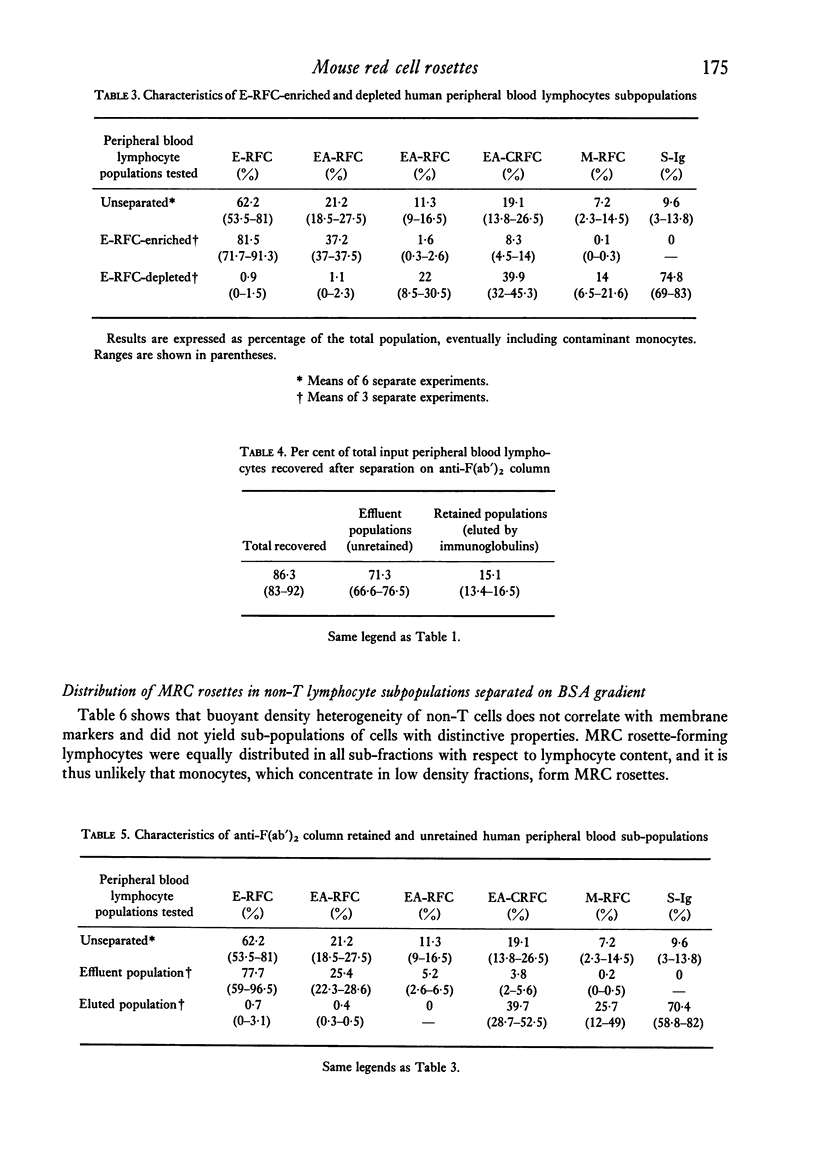
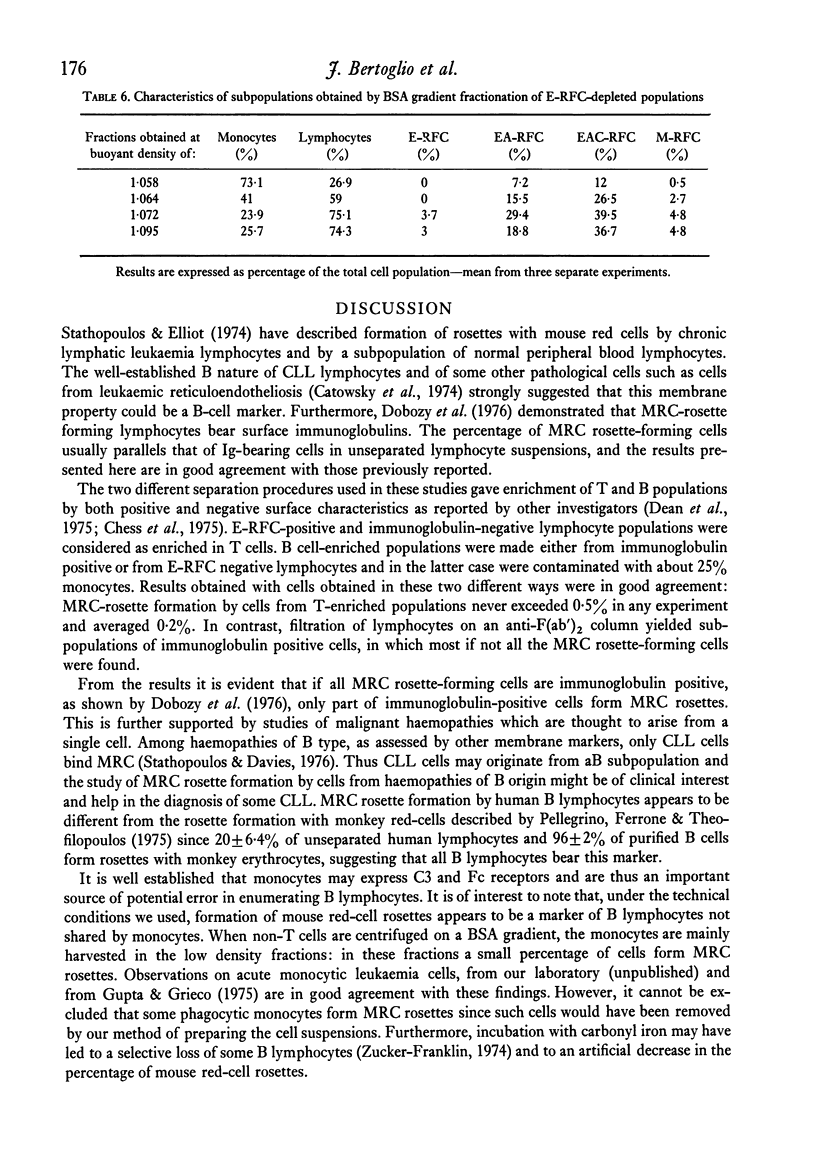
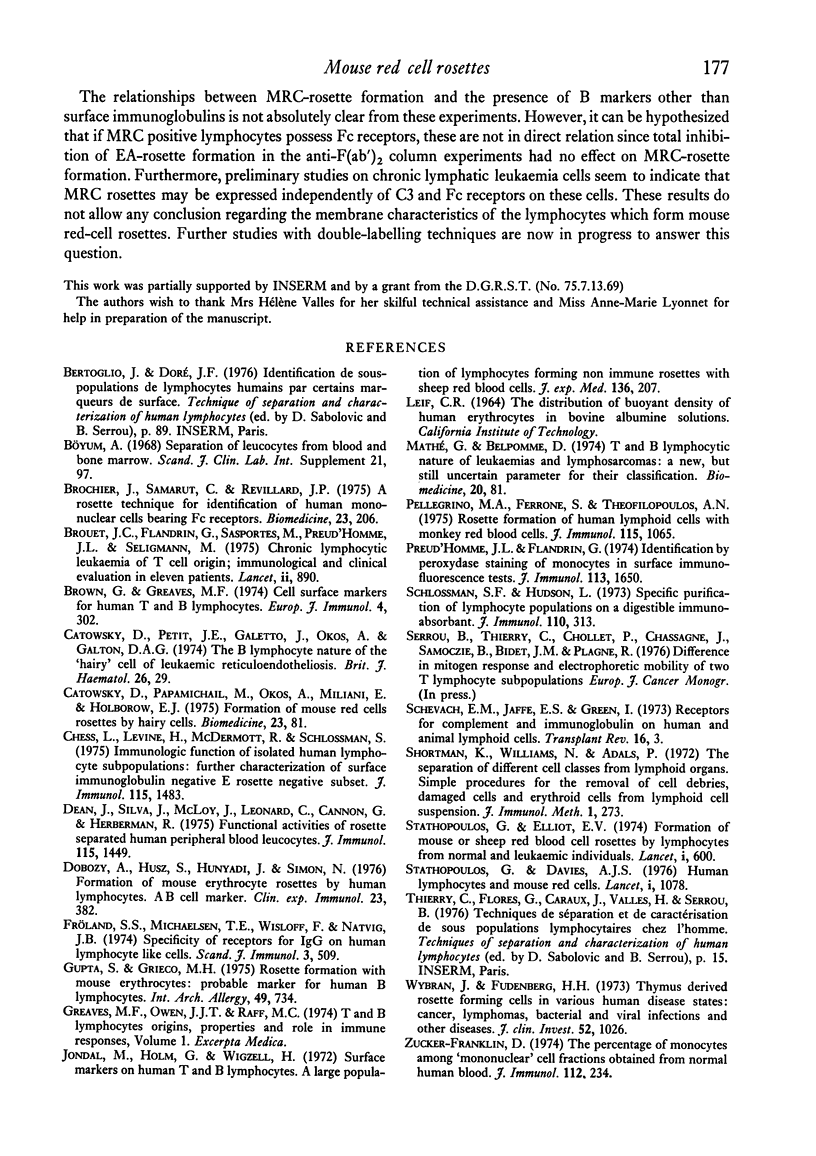
Selected References
These references are in PubMed. This may not be the complete list of references from this article.
- Brochier J., Samarut C., Revillard J. P. A rosette technique for identification of human mononuclear cells bearing Fc receptors. Biomedicine. 1975 Jun 30;23(6):206–209. [PubMed] [Google Scholar]
- Brouet J. C., Sasportes M., Flandrin G., Preud'Homme J. L., Seligmann M. Chronic lymphocytic leukaemia of T-cell origin. Immunological and clinical evaluation in eleven patients. Lancet. 1975 Nov 8;2(7941):890–893. doi: 10.1016/s0140-6736(75)92127-3. [DOI] [PubMed] [Google Scholar]
- Brown G., Greaves M. F. Cell surface markers for human T and B lymphocytes. Eur J Immunol. 1974 Apr;4(4):302–310. doi: 10.1002/eji.1830040414. [DOI] [PubMed] [Google Scholar]
- Catovsky D., Papamichail M., Okos A., Miliani E., Holborow E. J. Formation of mouse red cell rosettes by "hairy" cells. Biomedicine. 1975 Apr 10;23(3):81–84. [PubMed] [Google Scholar]
- Catovsky D., Pettit J. E., Galetto J., Okos A., Galton D. A. The B-lymphocyte nature of the hairy cell of leukaemic reticuloendotheliosis. Br J Haematol. 1974 Jan;26(1):29–37. doi: 10.1111/j.1365-2141.1974.tb00446.x. [DOI] [PubMed] [Google Scholar]
- Chess L., Levine H., MacDermott R. P., Schlossman S. F. Immunologic functions of isolated human lymphocyte subpopulations. VI. Further characterization of the surface Ig negative, E rosette negative (null cell) subset. J Immunol. 1975 Dec;115(6):1483–1487. [PubMed] [Google Scholar]
- Dean J. H., Silva J. S., McCOY J. L., Leonard C. M., Cannon G. B., Herberman R. B. Functional activities of rosette separated human peripheral blood leukocytes. J Immunol. 1975 Nov;115(5):1449–1455. [PubMed] [Google Scholar]
- Froland S. S., Michaelsen T. E., Wisloff F., Natvig J. B. Specificity of receptors for IgG on human lymphocyte-like cells. Scand J Immunol. 1974;3(4):509–517. doi: 10.1111/j.1365-3083.1974.tb01284.x. [DOI] [PubMed] [Google Scholar]
- Gupta S., Grieco M. H. Rosette formation with mouse erythrocytes: probable marker for human B lymphocytes. Int Arch Allergy Appl Immunol. 1975;49(6):734–742. doi: 10.1159/000231457. [DOI] [PubMed] [Google Scholar]
- Jondal M., Holm G., Wigzell H. Surface markers on human T and B lymphocytes. I. A large population of lymphocytes forming nonimmune rosettes with sheep red blood cells. J Exp Med. 1972 Aug 1;136(2):207–215. doi: 10.1084/jem.136.2.207. [DOI] [PMC free article] [PubMed] [Google Scholar]
- Mathé G., Belpomme D. T and B lymphocytic nature of leukemias and lymphosarcomas: a new but still uncertain parameter for their classification. Biomedicine. 1974 Mar;20(2):81–85. [PubMed] [Google Scholar]
- Pellegrino M. A., Ferrone S., Theofilopoulos A. N. Rosette formation of human lymphoid cells with monkey red blood cells. J Immunol. 1975 Oct;115(4):1065–1071. [PubMed] [Google Scholar]
- Preud'homme J. L., Flandrin G. Identification by peroxidase staining of monocytes in surface immunofluorescence tests. J Immunol. 1974 Nov;113(5):1650–1653. [PubMed] [Google Scholar]
- Schlossman S. F., Hudson L. Specific purification of lymphocyte populations on a digestible immunoabsorbent. J Immunol. 1973 Jan;110(1):313–319. [PubMed] [Google Scholar]
- Shevach E. M., Jaffe E. S., Green I. Receptors for complement and immunoglobulin on human and animal lymphoid cells. Transplant Rev. 1973;16:3–28. doi: 10.1111/j.1600-065x.1973.tb00115.x. [DOI] [PubMed] [Google Scholar]
- Shortman K., Williams N., Adams P. The separation of different cell classes from lymphoid organs. V. Simple procedures for the removal of cell debris. Damaged cells and erythroid cells from lymphoid cell suspensions. J Immunol Methods. 1972 May;1(3):273–287. doi: 10.1016/0022-1759(72)90005-1. [DOI] [PubMed] [Google Scholar]
- Stathopoulos G., Davies A. J. Letter: Human lymphocytes and mouse red cells. Lancet. 1976 May 15;1(7968):1078–1078. doi: 10.1016/s0140-6736(76)92254-6. [DOI] [PubMed] [Google Scholar]
- Stathopoulos G., Elliott E. V. Formation of mouse or sheep red-blood-cell rosettes by lymphocytes from normal and leukaemic individuals. Lancet. 1974 Apr 6;1(7858):600–601. doi: 10.1016/s0140-6736(74)92655-5. [DOI] [PubMed] [Google Scholar]
- Wybran J., Fudenberg H. H. Thymus-derived rosette-forming cells in various human disease states: cancer, lymphoma, bacterial and viral infections, and other diseases. J Clin Invest. 1973 May;52(5):1026–1032. doi: 10.1172/JCI107267. [DOI] [PMC free article] [PubMed] [Google Scholar]
- Zucker-Franklin D. The percentage of monocytes among "mononuclear" cell fractions obtained from normal human blood. J Immunol. 1974 Jan;112(1):234–240. [PubMed] [Google Scholar]


